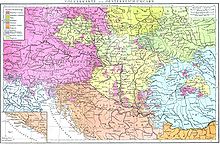Ruthenia



Ruthenia (derived from Ruthenia , which, along with Russia , Ruscia , Ruzzia or even Roxolania, was a Latin name for the Rus ) is a historical landscape name in German usage that various areas of Eastern Europe have borne throughout history , mostly in the area of the present-day states Ukraine and Belarus .
The inhabitants of the respective areas were called Ruthenians in German (rarely: Ruthenians ), the adjective is Ruthenian . The name Reußen is synonymous with Ruthenia (corresponding to [ the ] Reußen and Reussisch ); this form is found more frequently in older literature.
The word Ruthene is derived from the Latin ruthenus , which in turn is documented as the Latin equivalent of the ethnonym Rusin or Rusyn from the 11th century . In recent history, the term "Ruthenians" was often used to refer to the Eastern Slavs in the territory of the Grand Duchy of Lithuania and the Kingdom of Poland . Contemporaries such as Siegmund von Herberstein used the Latin word Rutheni for linguistic, cultural and historical reasons also in relation to the (great) Russians. In the following, however, the politically motivated Polish-Lithuanian tradition prevailed in Western Europe, according to which the word Ruthenians only applied to their own subjects, while the name "Muscovites" was reserved for the Great Russians. It was similar in the Austro-Hungarian monarchy, where in the 19th century people tried to use the Germanized Latin name to differentiate their own subjects from the Russians, who feared political sympathy among the "Ruthenians".
Due to its lack of clarity, the use of the name Ruthenia has repeatedly led to misunderstandings, one reason why it became unusable in the 20th century, except in historical treatises with a clear context. However, Ruthenia as an (unofficial) name for Carpathian Ukraine has recently become more common again.
Overview
The name Ruthenia (or Reuss ) is part of old landscape names :
- Belarus ( Belarus , also Belarus , comprised only part of the territory of the current state of Belarus)
- Black Ruthenia ( Black Russia , also Black Russia )
- Red Ruthenia ( Rotreußen or Rotrussland , also Galicia )
The rulers of the Grand Duchy of Lithuania temporarily held the title of rex ruthenorum ("King of the Ruthenians"), whereby "Ruthenians" still refer to all Eastern Slavs and no differentiation between Ukrainians, Belarusians and (Great) Russians is recognizable.
For the time of the Polish-Lithuanian Empire there were already two different terms for Ruthenia and Ruthenians :
- In the narrower sense: the Ruthenian Voivodeship , an administrative unit around the city of Lviv
- In a broader sense, Ruthenians understood the entire East Slavic population of the empire (with mostly Orthodox faith). The terms are derived from this:
- Ruthenian countries (more often: Reussian countries ): the settlement areas of the Ruthenians
- Ruthenian language : the common pre-form of Ukrainian and Belarusian spoken there
- Ruthenian metropolis : the Greek Orthodox Archdiocese in which the areas concerned were ecclesiastically organized
In the Habsburg and in particular the Austro-Hungarian monarchy , from 1772 to 1918 the East Slavic (Ukrainian-speaking) members of the empire were officially designated as Ruthenians . Derived from this:
- the language name Ruthenian for Ukrainian
- Occasionally the term Ruthenian also for the Ukrainian-speaking population in the Russian Empire
Ruthenia, also known as Carpathian Ukraine , came to Czechoslovakia in 1920 through the Treaty of Trianon , in which it received the status of an autonomous federal state. The terms Ruthenia and (Carpathian) Ruthenia remained in use for this area, while they otherwise disappeared.
- In Latin , Russia is also referred to as Russia as well as Ruthenia , while the present-day Ukrainian Galicia-Volhynia is listed in medieval sources as Russia , for example at the coronation of Prince Danylo of Galicia-Volhynia as Rex Russiae in 1253.
Trivia
- The chemical element ruthenium is named in honor of Russia, as both its first discoverer and namesake Gottfried Osann and Karl Ernst Claus , who is considered the discoverer by today's standards, worked as professors at Russian universities; In addition, the source ores came from deposits in the Urals . Osann, a professor in Dorpat (Tartu, today Estonia), whose results could not be verified, presumably had only obtained the element in impure form, so that Karl Ernst Claus from the University of Kazan is credited with the discovery of the element.
Individual evidence
- ↑ see Andreas Kappeler : Kleine Geschichte der Ukraine , München (Beck) 1994, p. 41.